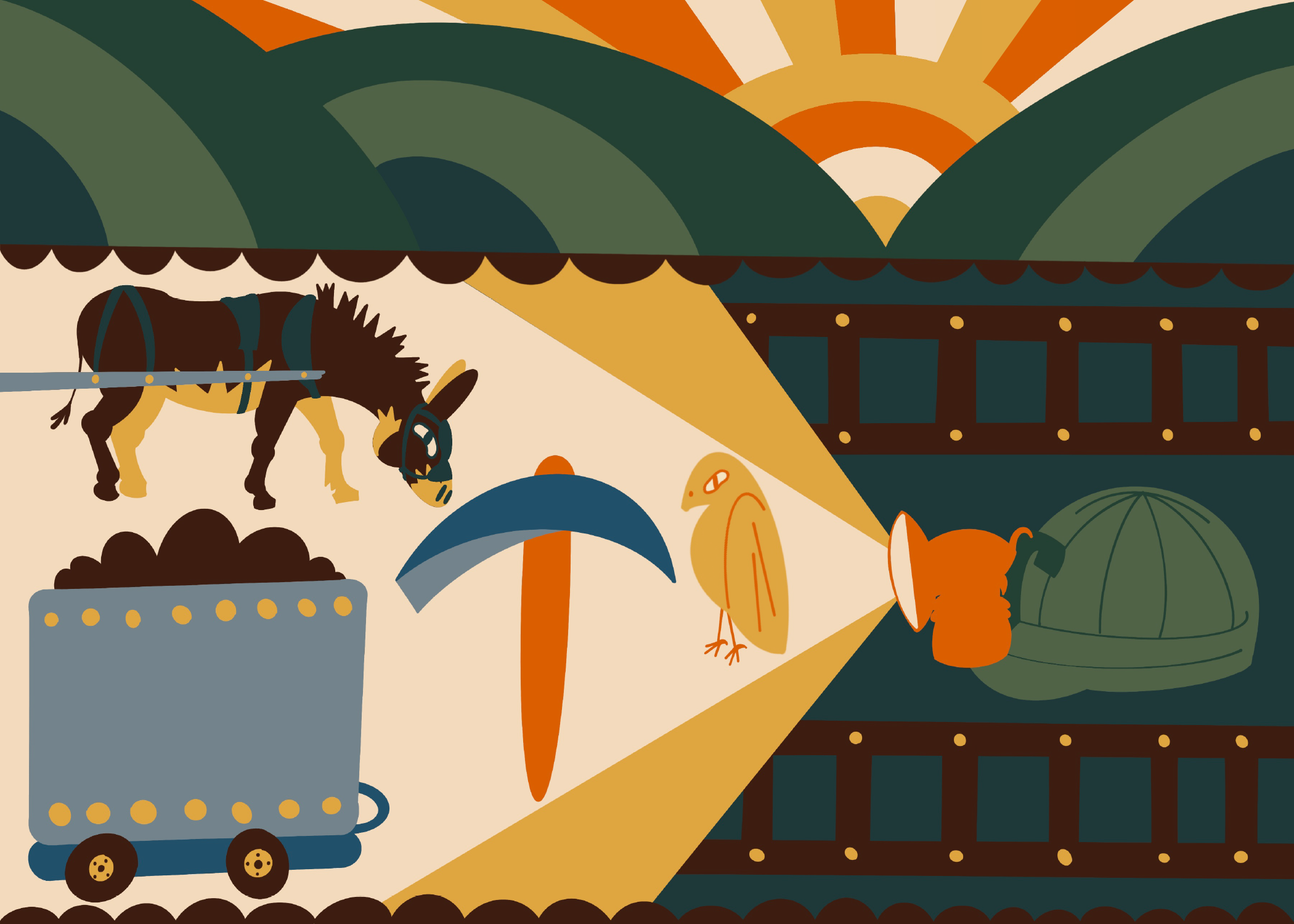Get the Postcards
If you would like to receive the postcards, consider becoming a Humanities Council Member. Your support will help us fund the next 50 years.
The postcards are illustrated by West Virginia artist Caroline Murphy.

WEST VIRGINIA’S POET LAUREATE FROM 1979 TO 1993, McNeill is best known as the author of Gauley Mountain, her first collection of poetry. Much of her writing was inspired by the Pocahontas County farm on which she grew up. In this book and others, McNeill applied her art to tasks normally associated with historians, biographers, and folklorists, preserving a rich vision of rural Appalachia and West Virginia. Many Council programs have supported the study of West Virginia’s literary voices.

A PROLIFIC PROSE AND SCRIPT WRITER, Grubb is best known for his novel The Night of the Hunter (1953), adapted into a classic film in 1955. Set around his home town of Moundsville, it tells the story of a serial killer pretending to be a preacher who menaces two young children in hopes of extracting the secret of their father’s ill-gotten wealth. Grubb is part of the literary landscape many Council grants and articles continue to nurture.

A LOGAN COUNTY NATIVE, AUNT JENNIE WILSON was a master of traditional clawhammer-style banjo playing. Wilson received the 1984 Vandalia Award, West Virginia’s highest folklife honor, for lifetime achievement in traditional music. The Council partnered with the William G. Pomeroy Foundation to facilitate the placement of a roadside Legends & Lore marker for Wilson at Chief Logan State Park in 2023.

BORN IN ALDERSON, SMITH WAS A DANCER, vaudeville performer, and entrepreneur known for her popular Parisian nightclub “Chez Bricktop.” Smith’s lifelong nickname was given to her by a New York saloon keeper in reference to her naturally red hair. She was inducted into the West Virginia Music Hall of Fame in 2013. The Council facilitated the placement of a roadside Legends & Lore marker for Smith in Alderson in 2020.

AMERICAN BOOK AWARD WINNER DENISE GIARDINA is the author of several novels, including Storming Heaven (1987), The Unquiet Earth (1992), and Good King Harry (1984), set in West Virginia and historical Europe. Giardina has lent her expertise to many Council grant projects and programs, including several seasons portraying Minnie Pearl for our History Alive! series.

BORN IN PRESENT-DAY MINGO COUNTY, Devil Anse was the patriarch of the Hatfield family during the infamous Hatfield-McCoy feud. Sensationalized interpretations of this dispute have shaped public perception of Appalachia for more than a century. These themes and the history of the feud were explored in a Council traveling exhibit that continues to be one of our most popular programs.

LEGEND SAYS THIS STEEL DRIVING MAN raced a steam drill during the building of a West Virginia railroad tunnel— and won. Although historians disagree about whether John Henry was a real person, his story has certainly made its mark on popular culture, inspiring blues songs, tall tales, and more— including a Council traveling exhibit in 2008 and a William G. Pomeroy Foundation Legends & Lore marker in 2019.

BUILT IN 1836, THE MACFARLAND-HUBBARD HOUSE is one of Charleston’s few remaining pre-Civil War homes. Lovingly restored by the Council in 1999, the Greek Revival home is more than just our headquarters—it is an important piece of the capital city’s history, as well as a meeting and programming space beloved by many Charlestonians.

BORN IN CHARLESTON, CRUMB WAS A PROLIFIC MUSICAL COMPOSER who won the Pulitzer Prize for his 1968 composition Echoes of Time and the River: Four Processionals for Orchestra. Crumb was inducted into the West Virginia Music Hall of Fame in 2007. Council grants have supported the Hall of Fame’s preservation of West Virginia musical voices for years.

CONSTRUCTED ALONG THE KANAWHA RIVER in the early 1900s, the Union Building was, at the time of its completion, the tallest in West Virginia. Most other buildings along the river were destroyed during the creation of Charleston’s Kanawha Boulevard in the 1930s. From 1990 to 2000, the Council made its home in the iconic structure’s Suite 800.

THE COAL MINERS OF THE MOUNTAIN STATE represent the peak of American 20th century industry. The diverse traditions brought to West Virginia by miners and their families—white and Black, immigrant and West Virginia born—remain very much in evidence across the state’s architecture, festivals, foodways, and more. The Council continues to explore this rich social, cultural, and labor history through myriad grants, lectures, curricula, and articles.

ORIGINALLY FOUNDED IN 1891, this historic institution grew into a national leader among the country’s Black colleges and universities. In addition to the distinguished historians, artists, scientists, athletes, and more that WVSU has produced through the decades, this postcard pays homage to the college’s World War 2–era pilot training program which gave rise to Black aviators like Rose Cousins and Col. George “Spanky” Roberts.
If you would like to receive the postcards, consider becoming a Humanities Council Member. Your support will help us fund the next 50 years.